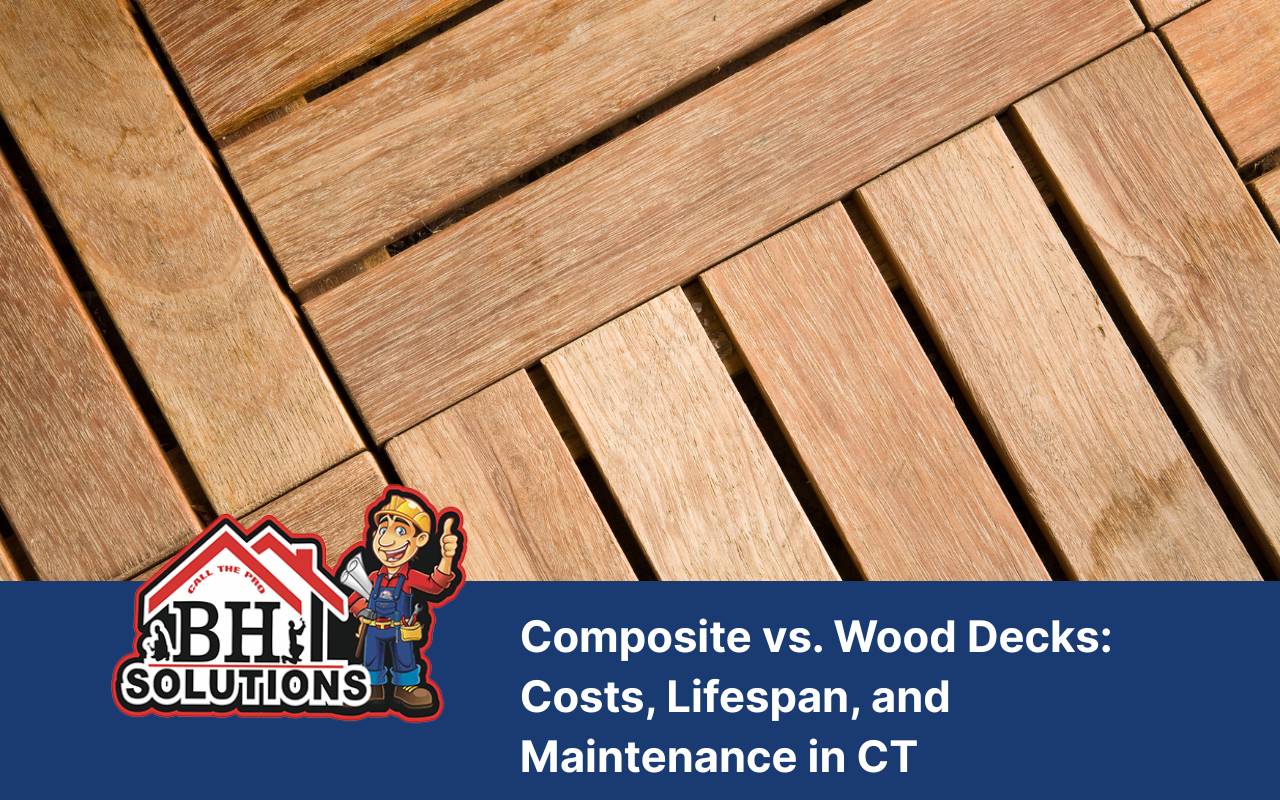
Home improvement choices can be challenging, especially when evaluating outdoor spaces. In Connecticut, the weather’s impact makes every detail matter. Choosing between a composite deck vs wood surface goes beyond style; it involves long-term performance, maintenance, and safety. While wood brings traditional appeal, composite materials such as TREX introduce innovative advantages that redefine outdoor living. By exploring options like deck resurfacing and considering factors such as slip resistance, homeowners can make well-informed decisions. Each material offers distinct benefits, but understanding how Connecticut’s climate affects durability is essential for lasting satisfaction. To learn more about professional home improvement solutions, visit BH Solutions USA for expert guidance and services.
Cost Analysis: Composite vs. Wood Decks
When comparing a composite deck vs wood, cost becomes a deciding factor for many homeowners. Composite materials, including trusted TREX brands, generally require higher initial investment. However, over time, lower seasonal maintenance helps balance that cost. Composite boards need minimal cleaning and no painting or sealing. Conversely, pressure-treated wood decks may seem affordable initially but demand frequent upkeep and materials like stains and sealants. These recurring expenses accumulate quickly. After 10 or 20 years, total costs may even out. Homeowners valuing reduced upkeep often find composite a practical choice, while others embrace wood’s timeless charm with consistent care.
- Composite decks cost more upfront but need less maintenance.
- Wood decks require regular cleaning and sealing.
- Long-term savings depend on upkeep commitment and material longevity.
Lifespan Comparison: Which Material Lasts Longer?
Another key aspect in the composite deck vs wood debate is lifespan. Composites blend recycled plastic and wood fibers, creating impressive resistance to rot and moisture. Many manufacturers provide warranties lasting up to 50 years. In contrast, pressure-treated lumber usually endures about 15 years, depending on weather and care. Routine deck resurfacing can extend its life slightly but requires ongoing effort. While composite decks maintain color and texture longer, wood surfaces naturally age, developing cracks or splinters. Each material can serve well if properly maintained, yet composites typically offer superior durability and reliability across decades.
- Composite decks resist insects and rot.
- Wood decks may need replacement after two decades.
- Proper maintenance improves lifespan for both materials.
Maintenance Requirements of Composite Decks
Composite decking provides a low-maintenance solution ideal for busy homeowners. It only requires occasional sweeping and a mild soap wash. No sealing, sanding, or repainting is necessary. This simplicity saves time and money while maintaining an elegant appearance. High-end brands include protective coatings that minimize fading. Although scratches can appear, they rarely require repair. For people seeking simplicity, composites deliver hassle-free upkeep without sacrificing style or performance. Their ability to withstand moisture and stains adds to their practicality, especially in Connecticut’s humid conditions.
Maintenance Needs of Wood Decks
Wood decks, particularly those built with pressure-treated lumber, demand continuous care. Seasonal maintenance ensures safety and durability. Cleaning twice a year removes dirt and organic buildup. Applying sealants and stains protects against moisture, sun exposure, and decay. However, such maintenance requires dedication and tools like power washers. Over time, wood may warp or split, necessitating deck resurfacing or replacements. Despite this, many homeowners appreciate the craftsmanship and warmth that come from maintaining natural wood. This connection between care and beauty remains appealing for traditionalists.
- Wood decks need annual sealing and staining.
- Moisture control prevents rot and damage.
- Resurfacing restores worn boards effectively.
Weather Resistance: How Each Material Handles Connecticut’s Climate
Connecticut’s varied climate challenges any deck material. Composite decks perform exceptionally well in extreme conditions. They resist snow, moisture, and UV rays, preventing warping and fading. Wood decks, even when pressure-treated, absorb moisture, leading to cracks or swelling during freeze-thaw cycles. Removing snow carefully helps avoid scratches or gouges. Cedar and redwood perform better than pine but still benefit from seasonal maintenance. Ultimately, composite decks provide more consistent results year-round, making them ideal for unpredictable weather patterns across the region.
Slip Resistance: Ensuring Safety for Your Outdoor Space
Safety remains a priority in any outdoor area. Composite decks are engineered with textured finishes to enhance slip resistance. Many TREX and other brands include grip-enhancing layers, ensuring stable footing even when wet. Pressure-treated wood can become slippery under rain or frost. Applying anti-slip coatings or grip strips improves traction. Regular cleaning removes moss and buildup, maintaining safety. Families with children or elderly members often favor composites for their dependable non-slip performance. This feature adds confidence and comfort throughout the seasons.
Environmental Impact: Sustainability of Composite and Wood Decks
Environmental awareness influences many homeowners’ decisions. Composite decking often uses recycled plastics and reclaimed fibers, making it an eco-conscious option. TREX brands, for example, highlight sustainable production processes. Wood decks sourced from responsibly managed forests can also support sustainability. However, chemical preservatives in pressure-treated wood raise environmental concerns. Composites, by reducing replacement frequency and minimizing waste, often result in a smaller ecological footprint over time. Balancing appearance with sustainability helps homeowners make responsible choices for long-term benefits.
Resurfacing Options for Wood Decks
Deck resurfacing revitalizes aged wooden structures without full reconstruction. The process includes sanding, cleaning, and resealing boards for a renewed look. This solution extends the deck’s lifespan and improves slip resistance. Some homeowners explore overlay materials resembling composites, offering a hybrid alternative. These overlays enhance texture and weather resistance. While resurfacing requires periodic effort, it allows homeowners to maintain the natural warmth of wood without total replacement. Careful upkeep guarantees both beauty and safety season after season.
Enhancing Aesthetics: Design Considerations for Composite and Wood Decks
Design creativity plays a significant role when comparing a composite deck vs wood. Composites come in various shades and patterns, from light gray tones to deep espresso finishes. Some boards feature reversible designs, allowing easy customization. Hidden fasteners and integrated lighting systems further elevate aesthetics. Wood decks, in contrast, display authentic grain patterns that age gracefully. Staining and painting provide endless color options, offering versatility in every project. Whether modern or rustic, thoughtful design ensures harmony between deck and home architecture.
FAQs About Composite and Wood Decks
What lasts longer, composite or wood decks?
Composite decks usually last decades longer due to resistance against rot, insects, and weather conditions.
How often should I clean my deck?
Composites need occasional washing, while wood requires seasonal maintenance including cleaning, sealing, and staining.
Can I resurface a composite deck?
Resurfacing is rarely necessary for composites, but wooden decks benefit from periodic resurfacing to maintain condition.
Which deck type offers better slip resistance?
Composite decking provides better traction, especially when wet, thanks to textured surfaces and advanced cap layers.
Are composite decks environmentally friendly?
Yes, composites often use recycled materials, reducing environmental impact while offering long-term durability and low waste.
Making the Best Choice for Your Connecticut Deck
Ultimately, the composite deck vs wood decision depends on lifestyle and budget. Composite decks deliver durability, minimal seasonal maintenance, and consistent slip resistance. Wood decks, however, bring authentic charm and hands-on satisfaction. Considering factors like resurfacing frequency and environmental responsibility helps narrow your choice. Evaluate how much effort you wish to invest and how long you want your deck to last. Both materials can thrive in Connecticut’s climate with proper care, ensuring your outdoor space remains inviting for many years to come.
